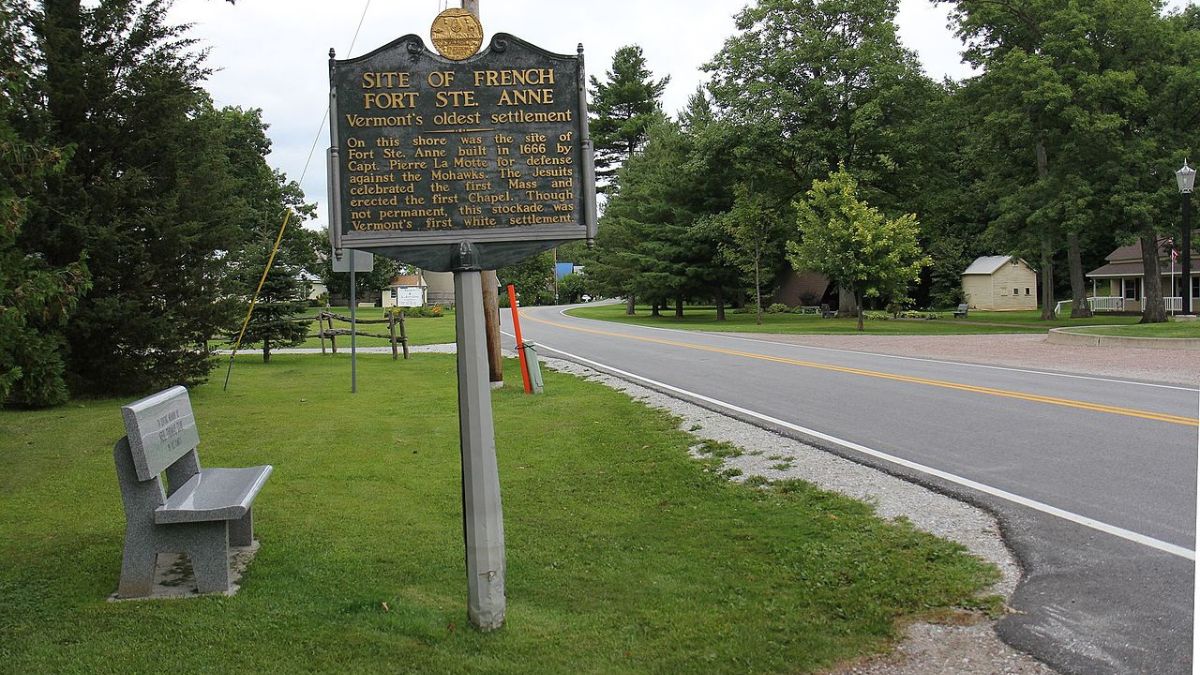Fort Sainte Anne in Vermont offers a rich slice of American history. Located on Isle La Motte, this fort played a significant role in the military strategies of the 17th century.
Its construction by French settlers highlights the area’s strategic importance during the colonial period.
Visitors to Fort Sainte Anne today can explore its historical ruins while enjoying the island’s natural beauty. The site provides a unique opportunity to reflect on the past while taking in picturesque views of Lake Champlain.
This blend of history and nature makes it a must-visit destination for history enthusiasts and outdoor adventurers.
Engaging with Fort Sainte Anne allows people to connect with Vermont’s lesser-known historical narratives.
The fort serves as a testament to the region’s colonial past and influence on its development. Understanding this aspect of Vermont’s history offers valuable insights into the early European settlements in North America.
History of Fort Sainte Anne
Fort Sainte Anne, located in Vermont, holds a notable place in history for its strategic importance and interactions between European settlers and Native American tribes. It played a critical role in the development and defense of New France.
European Settlers and the Iroquois

European settlers, led by Samuel de Champlain, established Fort Sainte Anne in 1666. This fort quickly became a focal point of conflict and cooperation with the local Iroquois tribes, particularly the Mohawk.
The Iroquois Confederacy, a powerful coalition of Native American tribes, saw these Europeans as potential allies and threats to their regional domain.
The settlers sought to secure alliances but engaged in conflicts, often resulting in negotiations and treaties. These early encounters significantly impacted both European colonial strategies and Iroquois diplomacy.
Military and Strategic Importance
Fort Sainte Anne’s placement was meticulously chosen for its strategic advantages. Located on Isle La Motte, the fort provided a vantage point to monitor and control movement along Lake Champlain.
This position was pivotal in defending New France from potential threats and facilitating trade routes.
The fortification included barracks, defensive structures, and supply depots, enhancing its capability to serve as a military outpost.
The fort saw numerous skirmishes and defensive actions to protect the region from British incursions and maintain French influence.
Fort Sainte Anne’s Role in New France
In the broader context of New France, Fort Sainte Anne was an essential outpost. It was a hub for exploration and expansion into Canada and the northeastern United States.
The fort was instrumental in the French efforts to establish a presence and expand territorial claims.
As a part of New France, Fort Sainte Anne contributed to the French colonial strategy of creating a network of fortified locations.
These outposts supported trade, facilitated military campaigns, and cemented France’s influence over vast territories. Despite its relatively brief functional period, Fort Sainte Anne’s impact on the region’s history was significant.
Geography Surrounding Fort Sainte Anne

Fort Sainte Anne is situated in a region marked by its distinct geographical features, including the rich history of Isle La Motte and the surrounding areas of Grand Isle County in Vermont.
Isle La Motte and Lake Champlain
Isle La Motte, located in Lake Champlain, is one of Vermont’s oldest and smallest inhabited islands.
This island is significant for its historical value and geological composition. Its proximity to Lake Champlain provides essential water routes and natural resources.
Lake Champlain stretches across Vermont, New York, and Quebec borders, serving as a critical waterway for trade and transportation.
Key Features of Isle La Motte:
- Part of the Champlain Islands
- Rich historical background
- Unique geological formations, including Chazy Reef
Lake Champlain’s Role:
- Provides vital fishing grounds
- Facilitates transportation and commerce
- Offers recreational opportunities
The relationship between Isle La Motte and Lake Champlain contributes to the area’s unique ecological and economic landscape.
Grand Isle County and Surrounding Regions
Grand Isle County is located in northern Vermont and includes several islands in Lake Champlain. Its topography includes flat terrain and rolling hills.
The county is surrounded by other noteworthy regions, such as Franklin County to the east and Chittenden County to the south. This geographical setting has influenced local agriculture, tourism, and community development.
Grand Isle County Overview:
- Composed of several islands, including Isle La Motte and Grand Isle
- Predominantly rural with agricultural activities
- Known for scenic beauty and outdoor activities
Surrounding Regions:
- Franklin County is known for dairy farming and agriculture
- Chittenden County is a hub for business and tourism
The interconnectedness of Grand Isle County with its neighboring regions enhances its cultural and economic significance in Vermont.
Religious and Cultural Impact

Fort Sainte Anne in Vermont is significant in religious and cultural terms. Catholic traditions strongly influence the site, which hosts one of Vermont’s prominent shrines and attracts many pilgrims.
Catholic Influence on the Site
French settlers established Fort Sainte Anne with a strong Catholic presence. Catholic Mass was regularly held at the site, making it a focal point for religious activities.
The influence of Catholic missionaries helped shape the culture, spreading Christianity among the local population. Religious artifacts and symbols remain pivotal in understanding the fort’s heritage.
Catholic families and communities often gather at the fort to remember and celebrate their faith, maintaining traditions passed down through generations.
Saint Anne’s Shrine and Pilgrimage Tradition
Saint Anne’s Shrine, located at Fort Sainte Anne, is a revered Catholic site. It was named in honor of Saint Anne, the mother of the Virgin Mary.
Thousands of pilgrims visit the shrine each year to attend Catholic Mass, pray, and seek spiritual solace. The pilgrimage tradition is deep-rooted, and well-organized events and services attract visitors from various regions.
The shrine serves as a place of worship and a communal space where people from different backgrounds come together, fostering a sense of spiritual unity and cultural continuity.
Current Status and Preservation

Today, Fort Sainte Anne attracts numerous visitors interested in its historical significance and preservation efforts. These efforts are led primarily by the Vermont Historical Society and include key attractions like Saint Anne’s Shrine.
Historic Sites and Tourism
Fort Sainte Anne’s site features several attractions aimed at preserving its history. Saint Anne’s Shrine is a significant draw, providing an educational experience about the fort’s historical background.
Visitors can explore reconstructed structures, informative plaques, and guided tours, making the site a key destination for those interested in Vermont’s historical landscape.
Tourism generated by these visits supports ongoing preservation efforts, ensuring the site’s continued maintenance.
Vermont Historical Society’s Efforts
The Vermont Historical Society has played a crucial role in preserving Fort Sainte Anne. They engage in research, restoration projects, and educational programs highlighting the fort’s importance.
The Society’s efforts include meticulous documentation of the site’s history and structural updates.
Funding for these initiatives comes from donations, grants, and partnerships with local organizations.
Educational programs often involve collaboration with schools, fostering a deeper appreciation for the state’s history among younger generations.
This ongoing commitment helps maintain Fort Sainte Anne’s historical integrity and public accessibility.
Explore More: 10 Historic Forts in Vermont: An Amazing Historical State
Media and Local Engagement
Fort Sainte Anne engages with the community through various media outlets and educational programs. These efforts help foster a deeper connection between the historical site and residents.
Local Media Coverage
Fort Sainte Anne is frequently featured in local media, such as Local 22, Local 44, and MyChamplainValley.com. These outlets regularly update events, historical discoveries, and preservation efforts.
This Place in History, a segment dedicated to exploring Vermont’s historical sites, often highlights the fort, drawing attention to its significance and activities.
This coverage ensures the fort remains a vibrant part of the local cultural landscape.
Public broadcast stations also air documentaries and special programs, further promoting public awareness about Fort Sainte Anne’s historical importance.
Educational Outreach and Community Involvement
Fort Sainte Anne offers various educational programs to engage the community. These include guided tours, field trips, and special educational events aligning with local school curricula.
Partnerships with U.S. educational institutions provide resources for in-depth historical research and learning.
Community involvement is encouraged through volunteer programs, local heritage events, and workshops on historical preservation.
These activities enhance public knowledge and foster a sense of ownership and responsibility toward local history among residents.
Daily Life at Fort Sainte Anne
Life at Fort Sainte Anne involved unique daily routines, shaped by various interactions between residents and indigenous peoples.
This section will explore the lifestyles of inhabitants and settlers and their trade relations with the Mohawk and others.
Habitants and Settlers’ Lifestyle
At Fort Sainte Anne, habitants and settlers maintained a daily schedule centered around farming, building, and maintaining the fort. Housing was typically modest, with structures built from local timber.
Meals were simple, often consisting of bread, vegetables, and occasionally meat or fish. Tasks such as harvesting, animal husbandry, and cooking were shared among community members.
Social gatherings and communal work were essential. Religious practice, led by local clergy, played a significant role in daily life, with regular services held in makeshift chapels.
Trade and Relations with Indigenous Peoples
Trade was a crucial aspect of life at Fort Sainte Anne. The settlers engaged in regular exchanges with the Mohawk and other indigenous groups, trading items like metal tools, beads, and weapons for furs and food supplies.
These interactions required diplomacy and mutual respect. They often involved negotiations led by both French and indigenous leaders. The fort was a meeting point where agreements and alliances were forged.
Relations were sometimes strained but generally cooperative, as both groups depended on the trade for survival and prosperity. Regular meetings and feasts helped to maintain these important relationships.
Fort Sainte Anne in Popular Memory
Fort Sainte Anne is significant in literature and U.S. military history. It represents a symbol of early American resilience and remains a poignant emblem in the cultural narrative.
Literature and Documentaries
Fort Sainte Anne frequently appears in historical literature describing early colonial and military life in Vermont.
The authors highlight the fort’s strategic importance during conflicts between European colonizers and indigenous peoples. Notable works include detailed accounts of sieges and daily fort operations.
Documentaries often explore the fort’s role in shaping Vermont’s defense strategies. Several have analyzed its construction, management, and impact on local communities.
These documentaries use a variety of sources, including diaries, military records, and expert interviews.
Symbolism in U.S. Military History
Fort Sainte Anne is symbolic in U.S. military history as an early bastion of colonial defense. It represents the struggle for land and influence among European powers in North America.
Military historians study the fort to understand the evolution of fortifications and defense tactics.
The fort’s legacy continues to be commemorated in Vermont through reenactments and educational programs. These activities emphasize the fort’s role in protecting settlers and influencing military architecture.
The site remains a significant landmark for understanding early American military strategy.

Cory is a website owner and content creator who enjoys fishing, history, coin collecting, and sports, among other hobbies. He is a husband and father of four.
Romans 15:4 For whatever was written in former days was written for our instruction, that through endurance and through the encouragement of the Scriptures we might have hope.

